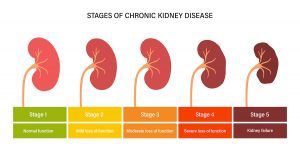March is National Kidney Month! That makes it the perfect time to go over the basics of chronic kidney disease. When left untreated, chronic kidney disease maintains its status as a progressive condition. The disease is classified by stages, corresponding to a spectrum of signs and symptoms and quantitative numbers.
A numeric value being assigned to a condition often brings a degree of fear and confusion. However, the stages of kidney disease help understand the pathological progression and guide the course of treatment.

Stages of Kidney Disease
Here, we are providing brief descriptions of these stages of kidney disease. By understanding each further, you can begin to see where you or a loved one may fall in the process:
Stage 1
Out of all the stages of kidney disease, Stage 1 kidney disease will rarely have any apparent symptoms and may not be caught if not a part of a regular check-up. It is characterized by kidney damage without abnormal kidney function and an estimated glomerular filtration rate, or eGFR, above 90. The eGFR measures the kidneys’ ability to filter blood adequately.
Many people may have this stage during their lifetime and never know since the symptoms never manifest. Particular lifestyle and dietary habits may make this a far greater risk, and if concerned, it is advised to check with a nephrologist to discuss strategies to prevent further disease. That is why understanding the stages of kidney disease is so important.
If symptoms are present, they will often overlap with late stage 1 and early stage 2 and may include hypertension and some swelling in the lower extremities. Additionally, UTIs may be present.
Stage 2
Stage 2 kidney disease is mildly progressed from stage 1 and is characterized by a mild loss of kidney function and an eGFR between 86-89. This is where symptoms will start to manifest and cause complications throughout daily life.
Stage 2 is often when individuals seek medical counsel for issues they feel should not be present, regardless of their current age or health status. Often, it is the introductory stage for many when they begin addressing their kidney health. Symptoms are the same as they overlap with late Stage 1.
Stage 3
One of the stages of kidney disease is broken into two parts. Stage 3 kidney disease contains Stages 3a and 3b. The former is characterized by mild to moderate loss of kidney function along with an eGFR of 59-45. The latter is characterized by moderate to severe kidney function loss and an eGFR of 44-30.
The symptoms of both of these stages of kidney disease will overlap to a degree and often include decreased blood cell counts, deep somatic bone pain, pain of an unexplained origin, numbness or tingling in the lower back and legs, as well as decreased mental acuity in response to blood imbalances.
This is a progressed stage of kidney disease and should not be the first time that symptoms are reported. As it is more severe, careful medical attention is necessary to minimize irreparable health consequences.
Stage 4
A severe loss of kidney function characterizes stage 4 kidney disease. It is the last stage of the disease before extreme life-altering interventions are required, such as dialysis or organ transplant, but it often progresses to this stage shortly after that. The body will start breaking down due to the inability of blood to contain adequate nutrients, secondary to poor filtration at the kidneys.
In this stage, anemia and decreased bone health will be present. In addition, a lack of appetite and low levels of essential vitamins may be detected, leading to secondary health issues. eGFR values will fall within the 15-29 range.
Stage 5
Stage 5 kidney disease is essentially the point where potential life-saving actions are required. All normal kidney function ceases to carry on appropriately, and regular dialysis is required in addition to the push for a transplant.
During this stage, systemic failure can occur, making activities of daily living extremely challenging. Persistent shortness of breath, nausea and vomiting, swelling, and extreme pain in the lower back may be present. Additionally, bone health is likely to suffer greatly, increasing the risk of fractures and other injuries. eGFR levels are below 15 in stage 5.
What To Do Next
While kidney disease can be daunting, understanding where one is along the progression stages of kidney disease is essential for preparing an appropriate care plan with one’s medical team.
Listening to your provider and respecting their medical advice will help you achieve the best possible outcomes for both short-term and long-term care, allowing a better quality of life for years to come.
Do you have questions about the stages of kidney disease? It may be time to see a nephrologist for more information. Our team of providers at Durham Nephrology has over 30 years of experience in managing and treating kidney disease. If you or someone you love has already been diagnosed with kidney disease, call (919) 477-3005 or visit our website to schedule an appointment.
